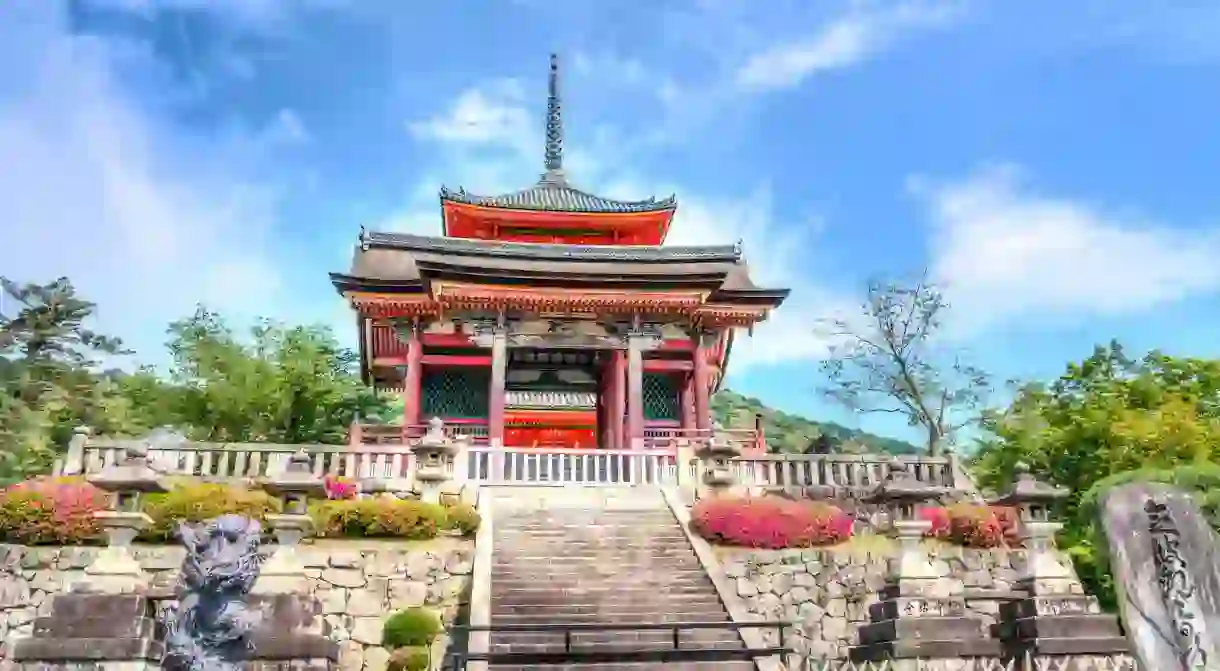The 6 Most Beautiful Temples in Kyoto

Kyoto is one of Japan’s most important religious hubs. With over one and a half thousand temples and shrines, 16 of which are UNESCO World Heritage Sites, it can be difficult choosing which temples to visit. Here, we make a list of the best off-the-beaten tracks temples in Japan’s most picturesque and historic city.
Tofuku-ji Temple (東福寺)
Bridge

Tofuku-ji is one of the largest temples in Kyoto, and one of the most important temples in the Zen sect of Buddhism. This temple was first built in the 13th century, and throughout the centuries additions and renovations have been made to the temple buildings and grounds, so that it is now a mix of styles from Imperial Japan’s eras. Each of the gardens in the temple has a distinct style, from striking rock gardens to picturesque ponds to lush greenery. The temple is especially famous for its autumn foliage, when the maple leaves turn red and orange.
Opening hours: 9am – 4:30pm (Apr – Oct), 8:30am – 4:30pm (Nov – early Dec), 9am – 4pm (early Dec – Mar)
Watch out for: The view from the Tsutenkyo Bridge, especially during fall foliage season
Opening hours: 9am – 4:30pm (Apr – Oct), 8:30am – 4:30pm (Nov – early Dec), 9am – 4pm (early Dec – Mar)
Watch out for: The view from the Tsutenkyo Bridge, especially during fall foliage season
Saiho-ji Temple (西芳寺)
Buddhist Temple
One of Kyoto’s 17 UNESCO World Heritage Sites, Saiho-ji is a gorgeous Zen Buddhist temple that is a timeless oasis of serenity. This half-hidden temple is famous for its moss garden, which has earned the temple its nickname of Koke-dera, which literally means “moss temple”. With over 120 different species of moss growing, the garden has an otherworldly hush to it that can give you a sense of peace. To enter, however, you must book well in advance, and partake in the Buddhist practices of kito and shakyo when you arrive at the temple.
Opening hours: 6am – 4pm
Watch out for: The atmospheric moss garden
Opening hours: 6am – 4pm
Watch out for: The atmospheric moss garden
Kurama-dera Temple (鞍馬寺)
To truly step away from the hubbub of the city, you might want to take a trek into the lush woodlands of Kitayama, the mountain north of Kyoto city. Hidden in the mountains is the village of Kurama, which is famous for its natural onsen (hot springs), and the Kurama-dera temple. Seated on a mountain slope, this temple seems part of the natural scenery, giving it a sense of spirituality lacking in many of the more touristy shrines. You can hike up to the temple from the town, while admiring the beauty of Japan’s native forests and the striking changes they make with the seasons.
Opening hours: 9am – 4:30pm
Watch out for: The breathtaking view from the temple
Opening hours: 9am – 4:30pm
Watch out for: The breathtaking view from the temple
Nanzen-ji Temple (南禅寺)
Museum
The head temple of the Rinzai sect of Zen Buddhism, Nanzen-ji is one of the biggest temples in Kyoto, with sprawling grounds at Higashiyama, just outside of Kyoto’s city centre. Here, you can see all the best and most distinctive features of Japanese temples; Nanzen-ji has dozens of subtemples within the grounds, separated by artfully and deliberately landscaped gardens with streams, trees, and paths to wander around. One of the most unique aspects of Nanzen-ji’s grounds is the hidden grotto behind a waterfall, concealed in the hillside just behind the temple.
Opening hours: 8:40am – 5pm (Mar – Nov), 8:30am – 4:30pm (Dec – Feb)
Watch out for: The Zen garden of rocks
Opening hours: 8:40am – 5pm (Mar – Nov), 8:30am – 4:30pm (Dec – Feb)
Watch out for: The Zen garden of rocks
Tenryu-ji Temple (天龍寺)

If you are planning a trip to Arashiyama, the mountains to the west of Kyoto, be sure to make time to visit Tenryu-ji. The first of Japan’s five most important Zen temples, Tenryu-ji is one of the most picturesque in Japan, displaying shakkei – literally translated to “borrowed scenery”, which means that the natural landscape interacts with the landscaped features of the garden for maximum pleasure in viewing. The pond and waterways of the garden are bordered by the natural forests of Arashiyama, showing off nature’s natural changes, from pale pink sakura blossoms, to thick green foliage, to fiery autumn colours.
Opening hours: 8:30am – 5:30pm (21st Mar – 20th Oct), 8:30am – 5pm (21st Oct – 20 Mar)
Watch out for: The famous bamboo grove just outside the temple
Opening hours: 8:30am – 5:30pm (21st Mar – 20th Oct), 8:30am – 5pm (21st Oct – 20 Mar)
Watch out for: The famous bamboo grove just outside the temple
Shoren-in Temple (青蓮院)
Buddhist Temple

If you’re a big fan of gardens and landscaping, you have to visit Shoren-in. This is one of the best temples for walking around, meditation, or simply to calm down from the hectic rush of Kyoto’s more touristy spots. Despite its small size, compared to many of the more famous temples, this Tendai Buddhist temple is beautifully arranged and features bamboo groves, a wide grassy field, and meandering brooks. Located at the bottom of the Higashiyama mountains, Shoren-in was first constructed as a place of residence for the son of a Japanese Emepror, and over time, the imperial resident evolved into a temple.
Opening hours: 9am – 5pm, 6pm – 10pm (nights with light shows in spring and autumn)
Watch out for: Tea ceremonies at a secluded tea house on the grounds By Elizabeth Lee
Opening hours: 9am – 5pm, 6pm – 10pm (nights with light shows in spring and autumn)
Watch out for: Tea ceremonies at a secluded tea house on the grounds By Elizabeth Lee













